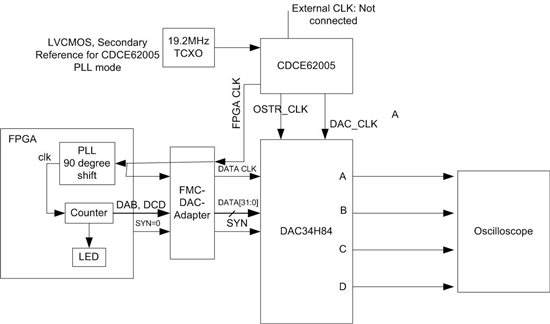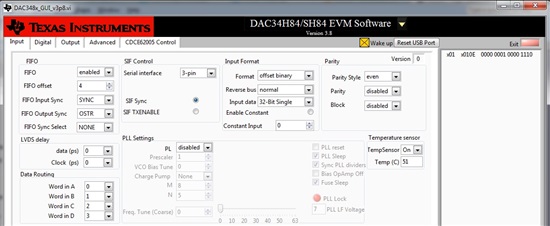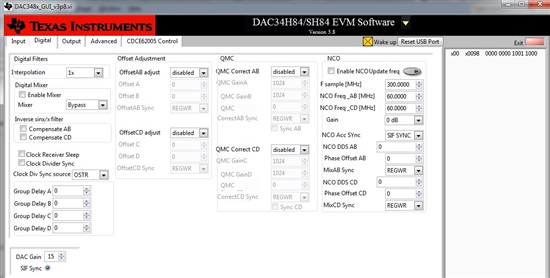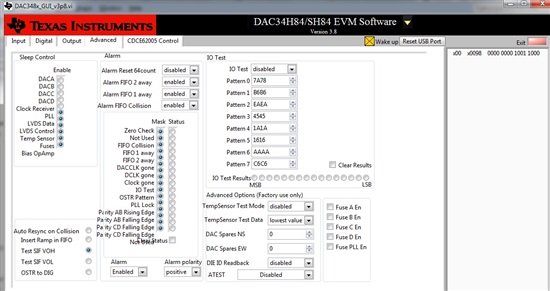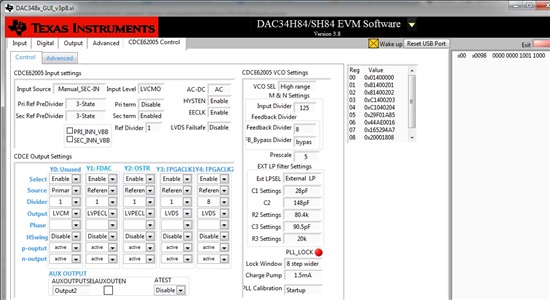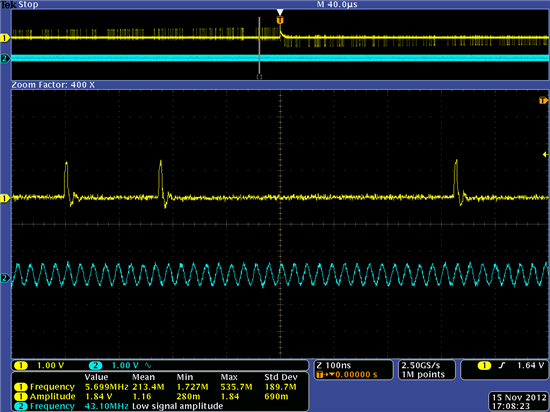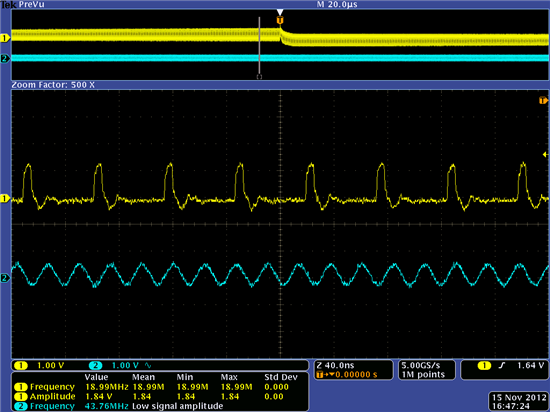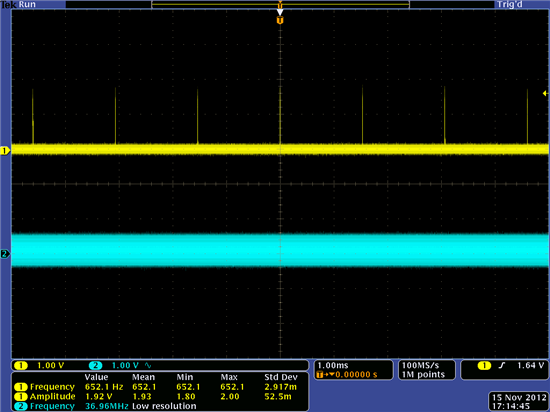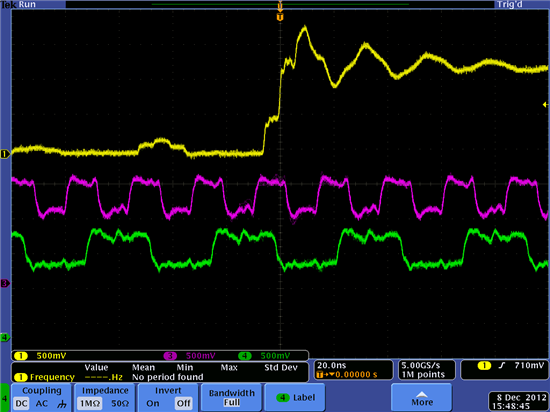Hi all,
I encountered some problems when testing the dac34h84evm. The DAC board is connected with the Xilinx VC-707 FPGA board using the FMC-DAC-adapter.
The clock for data (DCLK) is from the CDCE62005 whose frequency is 19.2 MHZ, the same as DAC's input clock (DAC_CLK). Data is center-aligned. We use the software(DAC348x EVM Software GUI (Rev. B) ) to configure it. Only FIFO is enabled and x1 interpolation. But we don't get the analog output on the oscilloscope. Whatever data we input. i.e. DA=DA+1 or constant value, we get nothing but some pulses.
I checked the connection of FMC on FPGA to FMC-DAC adapter which is correct, so i don't think the input "DA" is wrong. So I don't know exactly what goes wrong. Please help. You can reach me at jamesfade_1234@hotmail.com or this reply. Thanks a lot.
I attach my VHDL interface code.
--===================================
-- intf_TI_dac34h84evm
-- Description: This module is used to connect with FPGAs with HSMC port for Terasic ADA
-- (1) data is center-aligned.
--==================================
library ieee;
use ieee.std_logic_1164.all;
use ieee.std_logic_arith.all;
use ieee.std_logic_unsigned.all;
-- obufds library
Library UNISIM;
use UNISIM.vcomponents.all;
library work;
entity intf_TI_dac34h84evm is
port (
FPGAOUT_CLKP_I : in std_logic;
FPGAOUT_CLKN_I : in std_logic;
--PARITYP : out std_logic; --PARITYABP: Sync the FIFO pointer or act as a parity input for the AB-data bus
--PARITYN : out std_logic;
SYNCP : out std_logic; --SYNCP: allow complete reversal of the data interface when setting the rev_interface bit in register config.
SYNCN : out std_logic;
-- FIFO_ISTRP : out std_logic; --ISTRP: act with SYNC, PARITY.
-- FIFO_ISTRN : out std_logic;
DATA_CLKP : out std_logic; --DATACLKP: LVDS positive input data clock. Data are lutched on both edges of DATACLKP/N.
DATA_CLKN : out std_logic;
IO_DAP : out std_logic_vector (15 downto 0); --DAB: data for AB-channel
IO_DAN : out std_logic_vector (15 downto 0);
IO_DBP : out std_logic_vector (15 downto 0); --DCD: data for CD-channel
IO_DBN : out std_logic_vector (15 downto 0)
);
end intf_TI_dac34h84evm;
Architecture Behavior of intf_TI_dac34h84evm is
------------ components ------------
component pll_div is
port(
clkin : in std_logic;
rst : in std_logic;
pwrdwn : in std_logic;
clkout0: out std_logic;
clkout1: out std_logic;
clkout2: out std_logic;
clkout3: out std_logic;
clkout4: out std_logic;
clkout5: out std_logic
);
end component pll_div;
------------
signal clk : std_logic;
-- signal PARITY : std_logic;
signal SYNC : std_logic;
-- signal FIFO_ISTR : std_logic;
signal DATA_CLK : std_logic;
signal IO_DA : std_logic_vector (15 downto 0);
signal IO_DB : std_logic_vector (15 downto 0);
signal clkin : std_logic;
signal FPGAOUT_CLK : std_logic;
begin
--=======================================================
-- Dac34h84evm outputs
--=======================================================
--PARITY
-- OBUFDS_inst_PARITY : OBUFDS
-- generic map (
-- IOSTANDARD => "DEFAULT")
-- port map (
-- O => PARITYP,
-- OB => PARITYN,
-- I => PARITY
-- );
--SYNC
OBUFDS_inst_SYNC : OBUFDS
generic map (
IOSTANDARD => "DEFAULT")
port map (
O => SYNCP,
OB => SYNCN,
I => SYNC
);
--FIFO_ISTR
-- OBUFDS_inst_FIFO_ISTR : OBUFDS
-- generic map (
-- IOSTANDARD => "DEFAULT")
-- port map (
-- O => FIFO_ISTRP,
-- OB => FIFO_ISTRN,
-- I => FIFO_ISTR
-- );
--DATA_CLK
OBUFDS_inst_DATA_CLK : OBUFDS
generic map (
IOSTANDARD => "DEFAULT")
port map (
O => DATA_CLKP,
OB => DATA_CLKN,
I => DATA_CLK
);
--IO_DA
IO_DA_GEN: for j in 0 to 15 generate
begin
OBUFDS_inst_IO_DA : OBUFDS
generic map (
IOSTANDARD => "DEFAULT")
port map (
O => IO_DAP(j),
OB => IO_DAN(j),
I => IO_DA(j)
);
end generate IO_DA_GEN;
-- IO_DB
IO_DB_GEN: for j in 0 to 15 generate
begin
OBUFDS_inst_IO_DB : OBUFDS
generic map (
IOSTANDARD => "DEFAULT")
port map (
O => IO_DBP(j),
OB => IO_DBN(j),
I => IO_DB(j)
);
end generate IO_DB_GEN;
IBUFDS_inst_FPGAout_clk : IBUFDS
generic map (
DIFF_TERM => FALSE, -- Differential Termination
IBUF_LOW_PWR => TRUE, -- Low power (TRUE) vs. performance (FALSE) setting for refernced I/O standards
IOSTANDARD => "DEFAULT")
port map (
O => FPGAOUT_CLK,
I => FPGAOUT_CLKP_I,
IB => FPGAOUT_CLKN_I
);
-------------------
-- signals setup --
-------------------
-- clk is 90 degree in advance than DATACLK, so IO_DA and IO_DB is prepared before the rising edge of DATA_CLK
pll: pll_div
port map(
clkin => FPGAOUT_CLK,
rst => '0',
pwrdwn => '0',
clkout4 => clk
);
SYNC <= '0';
DATA_CLK <= FPGAOUT_CLK;
proc_counter: process(clk)
begin
if(clk'event and clk='1') then
IO_DA <= IO_DA+1;
end if;
end process proc_counter;
end Behavior;


